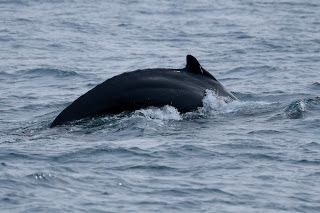The weather is always a challenge for us in February, which is why we set up each trip with a backup day for weather, but for three out of four recently scheduled trips that was not enough! We missed two in a row, and then it looked like we would miss another this week, so I scrambled and put another trip on for Monday, which turned out to be a nice day offshore. On Saturday, we ended up going out east of the inlet, and we had really good birding in the cold water on the shelf, but not so much out around the shelf break. On Monday, it was more of the reverse. Once we got more than ten miles out, it was pretty dull for the next 20 miles, but there was a lot of life out in the deeper water near "The Point". We found most of that action near a sharp temperature break on Monday. There was no such condition east of the inlet on Saturday. The water was warmer, but not as warm as it was Monday (70 degrees Fahrenheit), and there was no current edge.
Alcids continue to be the dominant attraction for us this month. Oregon Inlet is definitely a more consistent locale than Hatteras for seeing good numbers of the common species and so far this winter we have seen at least four species on each trip. Razorbills are usually the most numerous, but this year Dovekies have made a strong showing too. There were still a few puffins around, but not nearly as many as the week before. Common Murres might also be thinning out, but we had double digits each day. We did not find any Thick-billed Murres the last couple of trips.
On Monday we had our best numbers of Red Phalaropes so far this winter, which is not surprising as they do favor a sharp temperature break, and it was quite pronounced that day. Manx Shearwaters continue to be scarce- we only saw them on Saturday, and they were way inshore. It's always a treat to see Black-capped Petrel on a winter trip and we had good looks at one and more distant looks at a few more on Monday. There was hardly any wind, but the swell was pushed up by the Gulf Stream and the Black-caps were sailing around effortlessly on that. Little Gulls have been tough for us this year, but we did get onto one inshore and a couple offshore on Monday. The big surprise though, and the rarest find for us, was a first winter Black-headed Gull that Danny spotted on Monday. It was over 30 miles offshore and just inshore of the Gulf Stream change where there were many Bonaparte's Gulls feeding.
On Saturday there was not much to report for cetaceans, but on Monday we had a good variety. We had both coastal and offshore Bottlenose Dolphins in small numbers, but we had an epic showing of Common Dolphins, with at least 500 seen! We also saw at least five Humpback Whales, and had distant views of a pod of Cuvier's Beaked Whales.
I would like to thanks everyone who joined the trips, especially those who were able to make it out here for Monday on relatively short notice. As usual our crew, this time Daniel Irons and Ed Corey, were ever attentive and made sure we didn't miss anything out there, and still managed to get some nice images of what we saw. The bird lists follow the photos below.











.jpg)






















